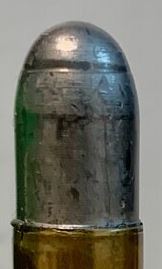What is the measured diameter of the whack mark/interference ring?
What is the measured diameter of the bullet nose, bare and coated?
A case separation into the chamber throat? Ugh.
It is very hard to measure the diameter at the interference ring, but my Mitutoyo digital caliper seems to consistently produce ab out .385" diameter at the base-end of the ring.
The following comparison of uncoated bullets and powder coated bullets, after sizing in the Lee sizer (which sizes only the bullet shank of course) is interesting for its unexpected outcome.
For it, I randomly slected 3 uncoated bullets and 3 coated bullets. I don't know how truly accurate the following measurments can be, since they depend on very accurately grasping the bullet ogive in the measuring device exactly barely above the topmost driving band. I did the 2 sets of 3 uncoated and 3 coated bullets twice, and got slightly different measurments and averages each time!
But, for what they are worth, the measured diameter of the base of the OGIVE, just above the topmost driving band, when measured with my Mitutoyo digital micrometer (for at least better accuracy than with the digital micrometer) appears to be:
Bare sized bullet = .447" (average of 3 bullets)
Powder coated and sized bullet = .449" (average of 3 bullets)
This implies roughly a .001" powder thickness after curing (.449 minus .447 divided by 2 since it is a
diameter we are measuring)
So the powder coating does of course increase the ogive diameter, but very slightly.
This would merely mean that the powder coated bullet will contact the rifle metal obstruction (wherevever it is) sooner, and therefor if we could somehow measure very accurately from the top of the top driving band to the bottom of the interference ring (we cannot), we would find that the measurement would be slightly higher for the powder coated bullet. But that difference is NOT responsible for the problem encountered here. NEITHER of the bullets, coated or uncoated, will chamber. The DIFFERENCE in exactly what depth they each encounter rifle metal resistance is ridiculosuly immnaterial. The interference here is not that subtle. It is mammoth
Again, it's the ogive shape that is causing this, and the severity of MY specific situation MIGHT be because I happened to get a mold that was cut by a new or almost new cherry. A new cherry would cut a larger mold cavity than a worn one, right?
Jim G




